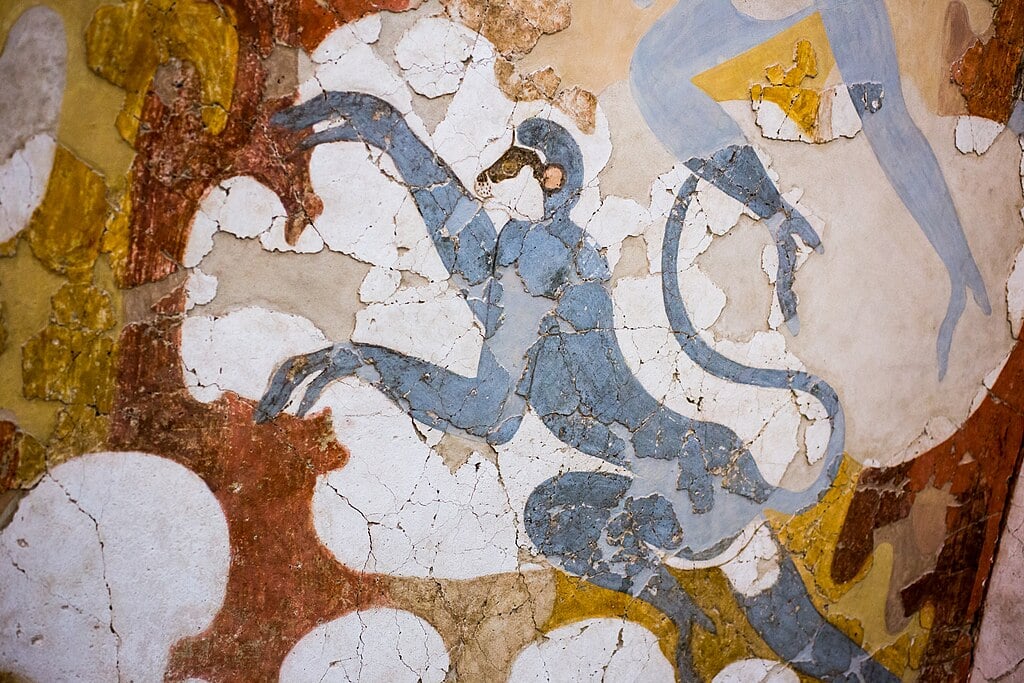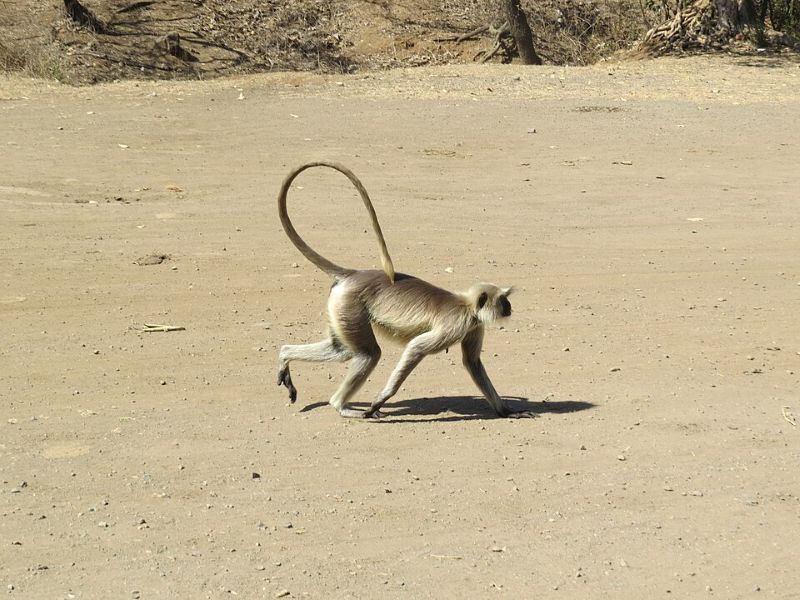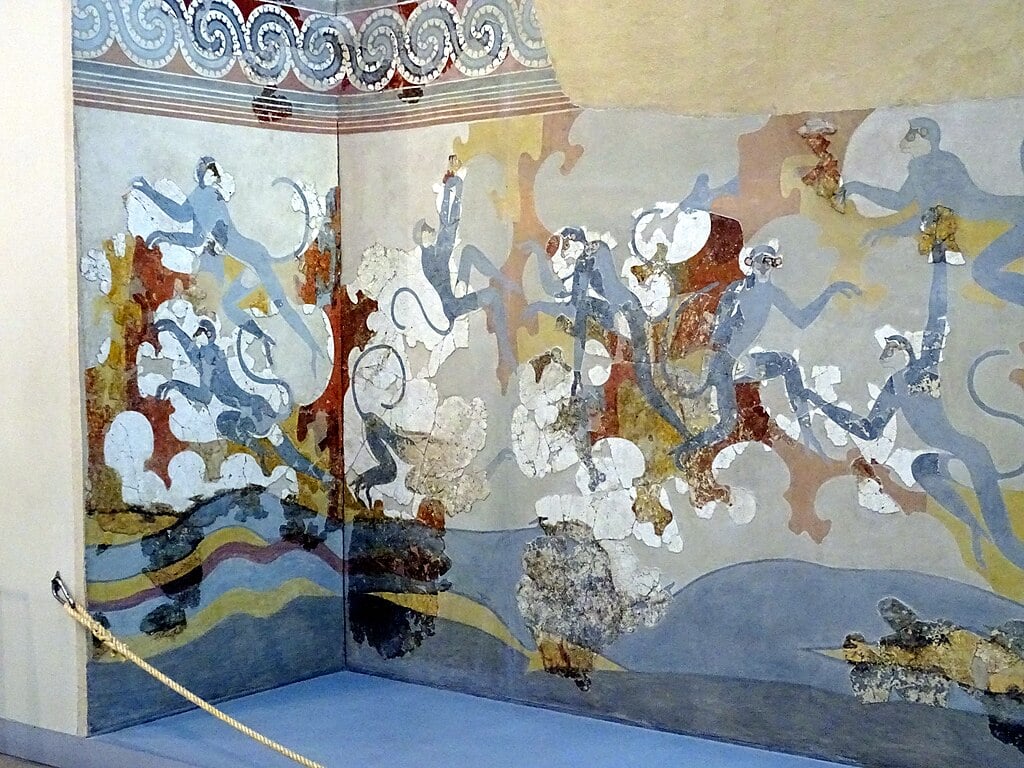
An academic study has stirred controversy over the Bronze Age Blue Monkeys fresco from Akrotiri, Santorini, regarded as one of the most enigmatic artworks of the ancient Greek world, suggesting the Silk Road may have opened 1,500 years earlier than than traditionally thought.
These spectacular frescoes, which depict monkeys, were painted over 3,600 years ago in Akrotiri, Santorini, one of the most stunning archaeological sites in the entire Aegean Sea.
For decades, scientists and scholars believed that these animals were African species, such as baboons. Nonetheless, this may be inaccurate.
A study suggests they might instead portray langurs from the Indian subcontinent rather than baboons. This is based on findings by a team of archaeologists and primatologists who published their research in the journal Primates in 2019, putting the prevailing theory to the test.

The study
Research on the Santorini fresco monkeys, led by Dr Marie Nicole Pareja—a former scholar of Durham University and now a Consulting Scholar at the University of Pennsylvania Museum—places previous interpretations under scrutiny. The study suggests that the monkeys depicted on the walls of Room 6 in Complex Beta at Akrotiri on Greece’s island of Santorini are not African at all but most closely resemble gray langurs native to India.
The frescoes date back to around 1600 BC, a time when the Minoan civilization on Crete had established robust trade networks throughout the Eastern Mediterranean, making it one of the most prosperous regions of the era. The question, therefore, is whether the Minoans had trade ties with societies much further than the Mediterranean.
The study, titled “A New Identification of the Monkeys Depicted in a Bronze Age Wall Painting from Akrotiri, Thera,” includes contributions from leading scholars in primatology: Dr. Tracie McKinney from the University of South Wales, Dr. Jessica Mayhew from Central Washington University, Dr. Joanna Setchell of Durham University, and illustrator Stephen D. Nash, a specialist in primate anatomy.
This group of experts undertook a detailed morphological analysis of the monkeys’ physical traits as depicted in the Santorini frescoes, focusing particularly on their long limbs, posture, and distinctive tail shapes—features that differentiate them from the African baboons with which we are more familiar.
According to these researchers, one of the most striking features of the Santorini fresco monkeys is their tails. This might seem like an insignificant detail at first glance, but this is not the case. The tails are shown in an upward arching “S” shape, a characteristic unique to langurs rather than baboons or vervets. In an interview with Smithsonian Magazine, Pareja maintained that “when you consider the distance of the Aegean to the Indus, compared to Egypt, it is incredible.”
The subject of the monkeys depicted in the Santorini frescoes at Akrotiri has long fascinated archaeologists and art historians alike. This is because their vivid colors and striking naturalism, combined with their location in a highly sophisticated Bronze Age settlement that was abruptly buried by a volcanic eruption, provide valuable archaeological evidence on a range of issues. The long-standing belief that the monkeys represented African species stems largely from existing evidence of trade ties between Minoan Crete and the New Kingdom of Egypt, where baboons were commonly imported from the land of Punt (modern-day Eritrea and Ethiopia).
However, Pareja and her colleagues argue that this assumption may have been too narrow. Their findings suggest that the Minoans may have had indirect contact with the Indus Valley Civilization—possibly through Mesopotamia or other intermediary cultures—which would explain how imagery or even live animals from South Asia might have found their way into frescoes in Greece.

The controversy over the monkeys of the Santorini frescoes
As you might expect, the study has not gone unchallenged. Scholars such as Bernardo Urbani of the Center for Anthropology at the Venezuelan Institute for Scientific Research in Caracas, Venezuela, and Dionisios Youlatos of the Aristotle University of Thessaloniki have published responses defending the traditional view of the monkeys as African species. They caution against overreliance on artistic interpretation, arguing that the stylized nature of Aegean frescoes cannot be precisely interpreted zoologically. In other words, they claim that the tails are being depicted in this way as a result of an artistic choice rather than based on knowledge of a species from the Indian subcontinent.
Pareja and her team addressed this criticism in a follow-up publication, defending their interdisciplinary approach and arguing that iconography can be extremely detailed and specific. The experts who conducted the study claim that the details of the monkeys on the Santorini frescoes “are rendered with such accuracy that the animals are clearly treated as individual animals … This treatment indicates that the artist probably observed the live animals, whether locally or (more likely) abroad.”
So far, no archaeological evidence has been uncovered to definitively prove that Indian monkeys were transported to the Aegean. However, the anatomical features depicted in the fresco, along with the presence of other exotic animals in Bronze Age art across the Aegean Sea, provide circumstantial evidence that the ancient Greek world was far more interconnected with distant lands than previously believed.


